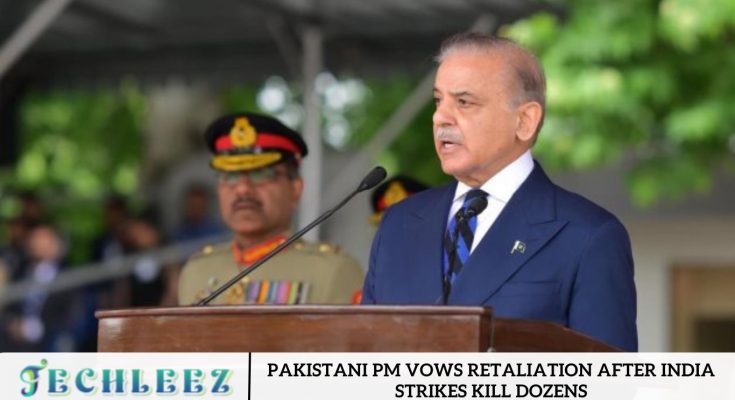A new chapter of hostility has opened between two nuclear-armed neighbors. After Indian airstrikes killed dozens inside Pakistani territory, Pakistan’s Prime Minister issued a stern warning, declaring the country would retaliate with “full force.” The statement has sent shockwaves across global diplomatic corridors and stirred fear of yet another military confrontation between two long-time rivals.
On the morning following the strike, sirens wailed in border towns. Social media flooded with videos of chaos and mourning. The Pakistani military confirmed that the airstrikes hit civilian and military targets near the Line of Control (LoC), resulting in at least 39 casualties. The Ministry of Foreign Affairs in Islamabad called it “an act of war.”
Background of the Flare-Up
The current conflict traces its roots to a decades-old dispute over the Kashmir region. Though the violence has ebbed and flowed over the years, certain incidents spark major escalations. The latest strike reportedly followed intelligence that a group planning attacks in Indian-administered Kashmir was hiding across the border.
Indian officials defended the operation, labeling it a “preemptive, intelligence-led strike to neutralize terrorist camps.” However, Pakistan strongly refutes those claims, insisting that no terror infrastructure existed at the targeted locations. Instead, Islamabad accuses New Delhi of fabricating a narrative to divert attention from internal political unrest.
Fury and Fire in Islamabad
Addressing the National Assembly in an emergency session, Prime Minister Shehbaz Sharif thundered: “India has crossed a red line. This unprovoked aggression will not go unanswered. We will respond — and we will respond at a time and place of our choosing.” His speech was met with thunderous applause from lawmakers and widespread support from the public.
Across the country, anti-India protests erupted. Crowds in Lahore, Karachi, and Rawalpindi held placards demanding retaliation. The streets echoed with chants, and the national media devoted non-stop coverage to what is now being termed as “Black Tuesday.”
Meanwhile, Pakistan’s military was placed on high alert. The Inter-Services Public Relations (ISPR) confirmed that fighter jets had been scrambled, and all airbases were prepared for any escalation.
India Stands Its Ground
In New Delhi, the Indian Defense Minister Rajnath Singh reiterated that India acted within its rights to defend its citizens. “We do not seek war,” he said at a press briefing, “but we will not hesitate to act when our sovereignty is threatened. The targets were carefully chosen, and collateral damage was avoided as much as possible.”
However, India’s opposition parties criticized the government’s lack of transparency. Some leaders demanded evidence of the alleged militant camps, questioning whether the strike was a political stunt ahead of upcoming elections.
Despite criticism, Prime Minister Narendra Modi maintained a hardline stance, declaring: “We will continue to root out terrorism wherever it hides.”
International Community Steps In
Global leaders wasted no time in responding. The United Nations Secretary-General António Guterres issued an urgent call for restraint, urging both nations to step back from the brink. “We are deeply concerned about the rising tensions in South Asia. Diplomacy must prevail over destruction,” he said in a statement.
Washington, London, and Beijing also issued similar statements. The U.S. Department of State advised both sides to “de-escalate immediately” and avoid further military action. China, a close ally of Pakistan, called the Indian strikes “destabilizing” and requested a closed-door session at the UN Security Council.
Meanwhile, Russia offered to mediate, echoing its past role in defusing similar tensions during the Kargil War and the 2019 Pulwama-Balakot crisis.
History of Border Conflict
Kashmir has remained a flashpoint between India and Pakistan since the partition of 1947. The two nations have fought three wars and engaged in countless skirmishes over the region. The LoC, which separates Indian- and Pakistani-controlled Kashmir, remains one of the world’s most militarized zones.
In recent years, ceasefire agreements have come and gone. The 2021 ceasefire deal brought hope, but incidents like the current one reveal the fragility of such accords. With both sides heavily armed and possessing nuclear capabilities, the consequences of miscalculation could be catastrophic.
Ground Realities and Civilian Cost
Beyond political grandstanding, the human cost is unbearable. In the village of Chakothi, near the strike zone, families buried loved ones wrapped in national flags. A mother of three, Naseema Bibi, lost her husband and son when their home was reduced to rubble. “We are not soldiers. We are just people trying to live,” she wept before reporters.
Hospitals in nearby Muzaffarabad and Rawalakot reported an influx of wounded civilians. Medical supplies began running low, and volunteer organizations issued urgent appeals for donations. The Pakistani Red Crescent Society confirmed that over 80 homes were either destroyed or damaged.
In India, reports surfaced of heightened military activity along the LoC, with some border villages placed under curfew. Schools were closed, and evacuation plans were drafted in several districts.
Media Wars and Information Battles
Alongside the physical conflict, an aggressive information war unfolded. State-run media on both sides released conflicting narratives. Indian outlets hailed the strikes as a decisive victory against terrorism, while Pakistani channels broadcast images of dead civilians and devastated homes.
Misinformation spread rapidly. Deepfake videos, edited images, and unverified claims flooded social media. Hashtags like #IndiaStrikes and #PakRetaliates trended globally, further polarizing online audiences.
Cyber experts warned of coordinated disinformation campaigns aimed at fueling nationalist sentiments. Both governments urged citizens to verify sources before sharing content online, though the warnings did little to slow the spread.
Military Movements Intensify
Satellite images analyzed by defense experts revealed increased troop deployments on both sides. Armored vehicles moved closer to the border, and surveillance drones were spotted in contested airspace. Pakistan Air Force jets flew multiple sorties over northern areas, indicating high operational readiness.
Pakistan’s Inter-Services Intelligence (ISI) reportedly held closed-door briefings with military commanders, outlining potential response strategies ranging from limited airstrikes to full-scale retaliation.
Meanwhile, India reinforced its northern command with additional personnel and artillery units. Both armies seemed to be preparing for the worst — while diplomats scrambled to prevent it.
Calls for Peace from Within
Amid the jingoism and retaliation rhetoric, a growing number of civil society voices called for peace. Pakistani human rights lawyer Asma Jahangir Foundation released a statement urging both governments to prioritize diplomacy over destruction.
In India, prominent authors, artists, and students rallied behind a “No War” campaign, holding peace vigils in Delhi and Mumbai. The campaign gained traction with the hashtag #NotInMyName trending across platforms.
Analysts noted a generational divide — while older citizens recall the horrors of previous wars, many young people on both sides push for regional collaboration, trade, and mutual respect.
Economic Repercussions Loom
Beyond the battlefield, both economies are already showing signs of strain. Stock markets in Karachi and Mumbai took a hit, with investors fearing prolonged instability. Crude oil prices spiked as the region edged closer to conflict.
Trade analysts predict a disruption in cross-border business, which had shown signs of revival after the pandemic. Agricultural exports, small-scale manufacturing, and cross-border transport are likely to suffer first.
International investors began pulling funds from South Asian markets, prompting central banks in both countries to issue reassurances. However, analysts warn that further escalation could deter foreign direct investment for years.
What Comes Next
The path ahead remains unclear. Both India and Pakistan claim moral and strategic justification. Both have domestic constituencies demanding strong action. Yet both also understand the cost of war — especially in an age where a single strike could spark nuclear catastrophe.
Backchannel diplomacy is reportedly underway, with third-party nations facilitating dialogue. The coming days will be critical. If cooler heads prevail, a new ceasefire could be brokered. If not, the region may once again plunge into prolonged conflict.
Regardless of politics, the people of South Asia yearn for peace. History has taught them that wars never truly resolve disputes — they only deepen scars. The world now watches, hoping wisdom triumphs over wrath.
Frequently Asked Question
What triggered the latest India-Pakistan conflict?
The recent escalation began after Indian airstrikes reportedly targeted sites in Pakistani territory, claiming to destroy terror camps. Pakistan claims the strikes killed dozens, including civilians, and labeled it an unprovoked act of aggression.
How did Pakistan respond to the Indian airstrikes?
Pakistani Prime Minister Shehbaz Sharif condemned the attack and vowed full retaliation. The military was placed on high alert, and air defense units were mobilized near the border.
What was India’s justification for the airstrikes?
India stated that the strikes were a “preemptive action” based on intelligence about terrorist groups planning attacks in Indian-administered Kashmir. The Indian government claimed only non-civilian targets were hit.
Were there civilian casualties in the attack?
Yes, Pakistani authorities confirmed that civilians were among the dozens killed. Reports from local hospitals and aid agencies support these claims, although India disputes civilian harm.
What has the international community said about the situation?
Global powers including the United States, China, Russia, and the United Nations have called for restraint. The UN has urged both nations to de-escalate tensions and resolve issues through dialogue.
Final Thoughts
This escalation is not just a test of military might — it’s a test of leadership, diplomacy, and humanity. The Pakistani Prime Minister’s vow to retaliate and India’s assertion of preemptive defense mark a dangerous threshold.




